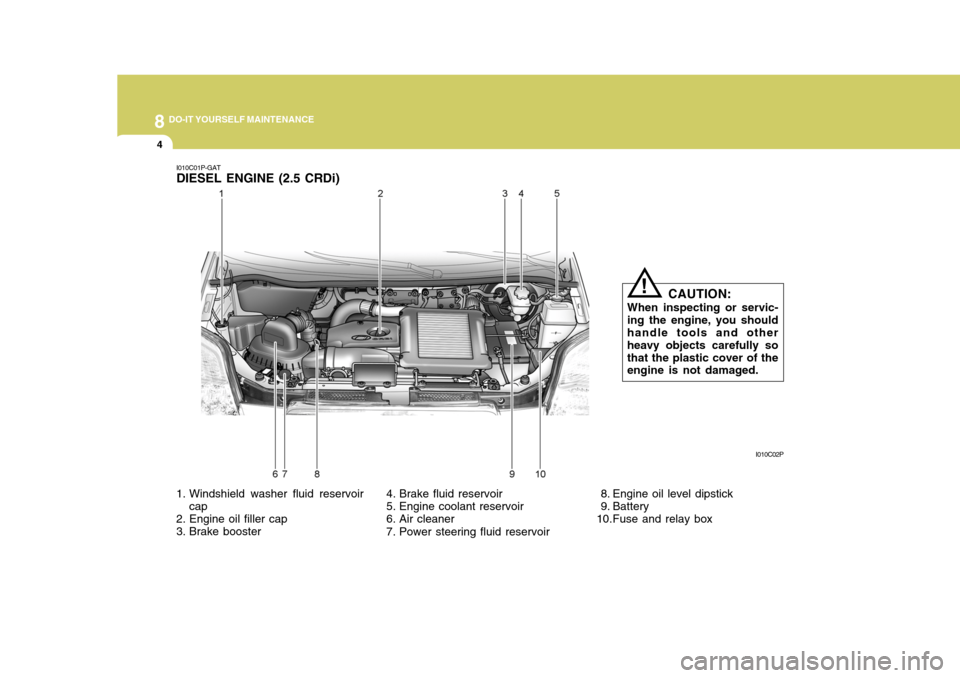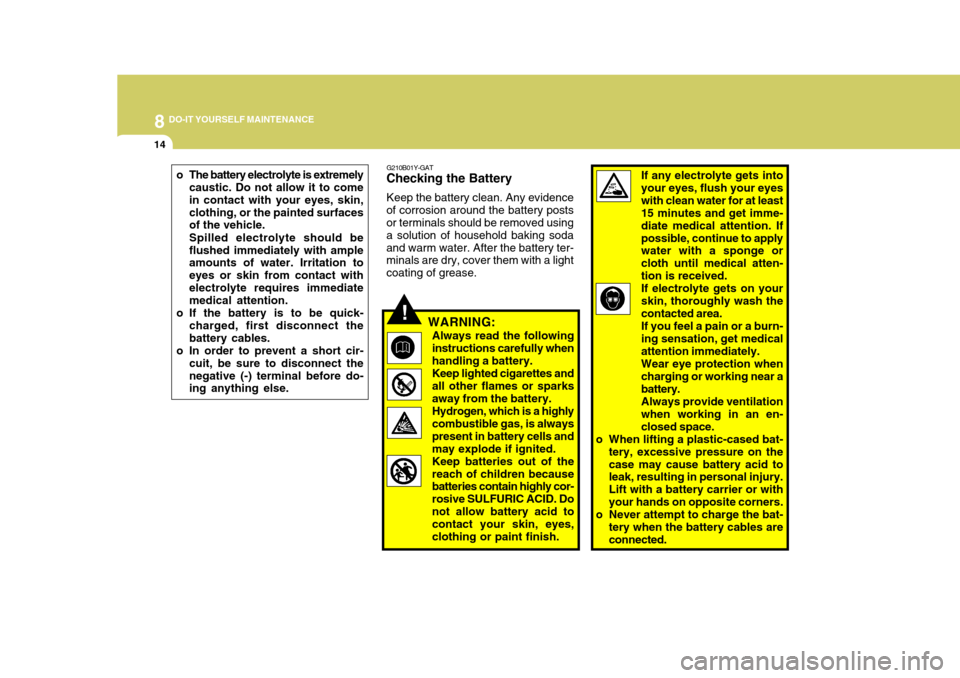2007 Hyundai H-1 (Grand Starex) battery
[x] Cancel search: batteryPage 246 of 284

8DO-IT YOURSELF MAINTENANCE
2ENGINE COMPARTMENT
1. Windshield washer fluid reservoir cap
2. Engine oil filler cap
3. Engine oil level dipstick
I010A01P-GAT DIESEL ENGINE (2.6 N/A)
4. Brake booster
5. Brake fluid reservoir
6. Radiator cap
7. Air cleaner 8. Power steering fluid reservoir
9. Battery
10.Engine coolant reservoirI010A01P-1
Page 247 of 284

8
DO-IT YOURSELF MAINTENANCE
3
I010B01P-GAT
DIESEL ENGINE (2.5 4D56)
1. Windshield washer fluid reservoir cap
2. Automatic transmission fluid level dipstick (If installed)
3. Engine oil filler cap 4. Engine oil level dipstick
5. Brake booster
6. Brake fluid reservoir
7. Engine coolant reservoir
8. Air cleaner 9. Power steering fluid reservoir
10.Battery
11.Fuse and relay boxI010B02P
Page 248 of 284

8DO-IT YOURSELF MAINTENANCE
4
I010C01P-GAT DIESEL ENGINE (2.5 CRDi)
1. Windshield washer fluid reservoircap
2. Engine oil filler cap
3. Brake booster 4. Brake fluid reservoir
5. Engine coolant reservoir
6. Air cleaner
7. Power steering fluid reservoir 8. Engine oil level dipstick
9. Battery
10.Fuse and relay boxI010C02P
CAUTION:
When inspecting or servic-ing the engine, you should handle tools and other heavy objects carefully sothat the plastic cover of the engine is not damaged.
!
Page 249 of 284

8
DO-IT YOURSELF MAINTENANCE
5
I011A02P-GAT
GASOLINE ENGINE (2.4 DOHC)
1. Windshield washer fluid reservoir
cap
2. Engine oil filler cap
3. Engine oil level dipstick 4. Brake booster
5. Brake fluid reservoir
6. Radiator cap
7. Air cleaner
8. Power steering fluid reservoir
9. Battery
10. Fuse and relay boxI011A03P
CAUTION:
When inspecting or servic-ing the engine, you should handle tools and other heavy objects carefully sothat the plastic cover of the engine is not damaged.
!
Page 250 of 284

8DO-IT YOURSELF MAINTENANCE
6GENERAL CHECKS
I020A03P-GAT Engine Compartment The following should be checked regu- larly:
o Engine oil level and condition
o Transmission fluid level and condi- tion
o Brake fluid level
o Clutch fluid level
o Engine coolant level
o Windshield washer fluid level
o Accessory drive belt condition
o Coolant hose condition
o Fluid leaks
(on or below components)
o Power steering fluid level and con-
dition
o Battery condition
o Air filter condition I030A03P-GAT Vehicle Exterior The following should be checked monthly:
o Overall appearance and condition
o Wheel condition and wheel nut tight-
ness
o Air cleaner filter condition
o Exhaust system condition
o Light condition and operation
o Windshield glass condition
o Wiper blade condition
o Paint condition and corrosion
o Fluid leaks
o Door and hood lock condition
o Tire pressure and condition
(including spare) I040A01P-GAT Vehicle Interior The following should be checked each time when the vehicle is driven:
o Light operation
o Windshield wiper operation
o Horn operation
o Defroster, heater operation
(and air conditioning, if equipped)
o Steering operation and condition
o Mirror condition and operation
o Turn signal operation
o Accelerator pedal operation
o Brake operation, including parking brake
o Manual transmission operation, in-
cluding clutch operation
o Automatic transmission operation,
including "Park" mechanism opera-tion
o Seat control condition and opera-
tion
o Seat belt condition and operation
o Sunvisor operation
Page 257 of 284

8
DO-IT YOURSELF MAINTENANCE
13
D010B02P
CHECKING THE BATTERY
!
G210A01A-AAT
WARNING:
Batteries can be dangerous! When working with batteries, carefully observe the following precautionsto avoid serious injuries. The fluid in the battery contains a
strong solution of sulfuric acid, which is poisonous and highly corrosive. Becareful not to spill it on yourself or the car. If you do spill battery fluid on yourself, immediately do the follow-ing: o If battery fluid is on your skin, flush
the affected areas with water for atleast 15 minutes and then seek medical assistance.
o If battery fluid is in your eyes, rinse out your eyes with water and getmedical assistance as soon as possible. While you are being drivento get medical assistance, continue to rinse your eyes by using a sponge or soft cloth saturated withwater.
o If you swallow battery fluid, drink a large quantity of water or milk fol- lowed by milk of magnesia, eat a raw egg or drink vegetable oil. Getmedical assistance as soon as possible.
While batteries are being charged(either by a battery charger or by the vehicle’s alternator), they produceexplosive gases. Always observe these warnings to prevent injuries from occurring:
o Charge batteries only in a well ven- tilated area.
o Do not permit flames, sparks or smoking in the area.
o Keep children away from the area. I090C01P-GAT Disconnection and connection Never disconnect the battery while the engine is running; doing so could damage the vehicle’s electrical com- ponents. First disconnect the nega-tive terminal and then the positive terminal. When connecting the bat- tery, first connect the positive termi-nal and then the negative terminal.
CAUTION:
o Keep the terminals clean. After the battery is connected, applyterminal protection grease. Toclean the terminals, use luke- warm water.
o Never short-circuit the battery; doing so could cause it to over- heat and be damaged.
o Do not smoke or bring an open flame near the battery; doing socould ignite the explosive gasgenerated by the battery.
!
Page 258 of 284

8DO-IT YOURSELF MAINTENANCE
14
o The battery electrolyte is extremelycaustic. Do not allow it to come in contact with your eyes, skin,clothing, or the painted surfaces of the vehicle. Spilled electrolyte should be flushed immediately with ample amounts of water. Irritation to eyes or skin from contact withelectrolyte requires immediate medical attention.
o If the battery is to be quick- charged, first disconnect the battery cables.
o In order to prevent a short cir- cuit, be sure to disconnect thenegative (-) terminal before do- ing anything else.
If any electrolyte gets into your eyes, flush your eyeswith clean water for at least 15 minutes and get imme- diate medical attention. Ifpossible, continue to apply water with a sponge or cloth until medical atten-tion is received.If electrolyte gets on yourskin, thoroughly wash the contacted area. If you feel a pain or a burn- ing sensation, get medical attention immediately. Wear eye protection when charging or working near a battery. Always provide ventilation when working in an en- closed space.
o When lifting a plastic-cased bat-
tery, excessive pressure on thecase may cause battery acid to leak, resulting in personal injury. Lift with a battery carrier or withyour hands on opposite corners.
o Never attempt to charge the bat-
tery when the battery cables areconnected.G210B01Y-GAT
Checking the Battery
Keep the battery clean. Any evidence
of corrosion around the battery posts or terminals should be removed using a solution of household baking sodaand warm water. After the battery ter- minals are dry, cover them with a light coating of grease.
!WARNING:
Always read the following instructions carefully when handling a battery. Keep lighted cigarettes and all other flames or sparks away from the battery. Hydrogen, which is a highly combustible gas, is always present in battery cells andmay explode if ignited.Keep batteries out of thereach of children because batteries contain highly cor- rosive SULFURIC ACID. Donot allow battery acid to contact your skin, eyes, clothing or paint finish.
Page 278 of 284

10INDEX
2
A ADJUSTABLE FRONT SEATS .................................. 1-32
AIR CONDITIONING CARE .......................................8-15
AIR CONDITI ONING SYSTEM .................................. 2-44
ALTIMETER ............................................................... 2-18
ANTENNA .................................................................. 2-73
ANTI-LOCK BRAKE SYSTEM ................................... 3-24
APPEARANCE CARE ................................................. 5-2
ASHTRAY .................................................................. 2-36
AUDIO FAULT CODE ................................................. 2-70
AUDIO SYSTEM Cassette Tape Player Operation (H240, H280)...................................................................... 2-54, 2-65
Compact Disc Player Operation (H260, H280) ...................................................................... 2-59, 2-67
Stereo Radio Operation (H240, H260, H280)
............................................................ 2-51, 2-56, 2-62
AUTOMATIC TRANSMISSION ..................................3-10
AUTOMATIC TRANSMISSION FLUID .......................8-18
AUXILIARY SEAT ...................................................... 1-38BBATTERY
................................................................... 8-13
BEFORE STARTING THE ENGINE ............................ 3-3
BI-LEVEL HEATING ................................................... 2-42
BLEEDING THE FUEL SYSTEM ............................. 4-21
BRAKE FLUID ............................................................ 8-17
BRAKE PEDAL .......................................................... 3-22
BRAKE SYSTEM ....................................................... 3-20
BULB WATTAGE ....................................................... 4-38
CCARE OF CASSETTE TAPES .................................. 2-72
CARE OF DI SC .......................................................... 2-71
CARRYING CHILDREN .............................................. 1-16
CATALYTIC CONVERTER ....... ................................... 7-3
CENTRAL DOOR LOCKS ..... .....................................1-15
CHANGING A FLAT TIRE ........................................... 4-7
CHANGING AND REPLACING FUSES .....................4-27
CHANGING THE CLIMATE CONTROL AIR FILTER . 8-16
CHECKING THE DRIVE BELTS ................................ 8-24
CHECKING THE FREEPLAY .....................................8-23
CHILD PROTECTION SLIDE DOOR ..........................1-16
CHILD RESTRAINT SYSTEM .................................... 1-46
CIGARETTE LIGHTER ............................................... 2-27
CLIMATE CONTROL AIR FILTER ............................. 2-47
CLUTCH FLUID .......................................................... 8-18